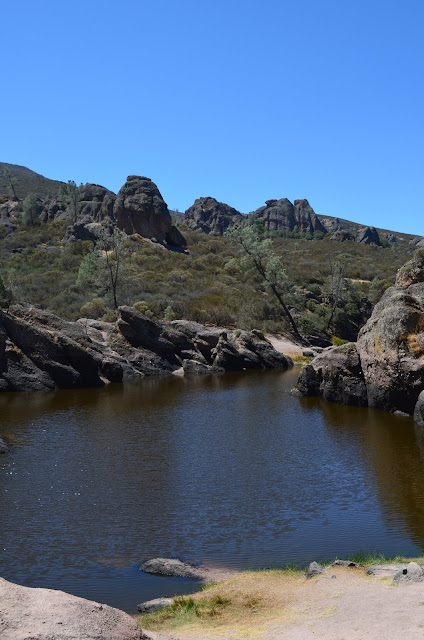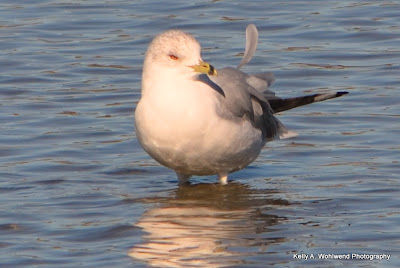Hint #11: Incorporate drawing and journaling in with your
 |
| Sample from my nature journal |
birding! It's a great way to allow you to explore other media than photography and you'll notice greater details and interesting behaviors by close observation. You'll be surprised what you find when you start sketching!
I just got back from a fantastic six day camping trip in the Sierras along Highway 49. I was taking a
nature journaling course and birding at the same time. In this post I'll show you some of the different habitats I visited, what birds I found there and birding hotspots around Hwy 49. I'll also share some of my bird sketches to hopefully inspire you to record what you see in a new, exciting way :)
I was shocked at how many different bird species I saw in the Sierras. So here it is, the list of all species seen and or heard in the Sierras. (?) = a questionable sighting. I am fairly confident on my ID but not enough to be certain. (*) = a species I have never seen before (a life species for me). I did not put (*) next to questionable sightings for my life list. (v) = the species was identified by vocalization only.
Grand Total Sierra Bird Count
((Total species: 61 (does not include questionable sightings). Total new personal life species: 19)) Alphabetized by common name
American avocet (v) Olive-sided flycatcher (v)
American bittern* Osprey
American coot Pied-billed grebe
American robin Pileated woodpecker (v)
 |
| Mountain Chickadee, photo by author |
Anna's hummingbird Pine sisken
Bald eagle Purple finch
Barn swallow Pygmy nuthatch
Black-headed grosbeak (v) Red-breasted nuthatch (v)
Brewer's blackbird Red-winged blackbird
Brown creeper Red-tailed hawk
Calliope hummingbird* Rufous or allen's hummingbird (female) (?)
Cassin's finch* Sandhill crane*
Chipping sparrow (v) Sage thrasher*
Clark's nutcracker* Savannah sparrow*
Cliff swallow* Steller's jay
Common raven Tennessee warbler (?)
Dark-eyed junco Turkey vulture
Downy woodpecker (v) Warbling vireo* (v)
Evening grosbeak Western tanager
Forster's tern* Western wood-pewee*
Fox sparrow - thick-billed White-faced ibis*
Gadwall White-headed woodpecker*
Great blue heron Willow flycatcher*
Green-tailed towhee* Wilson's warbler
Golden-crowned kinglet (v) Wood duck
Hermit thrush (v) Yellow-headed blackbird*
Hermit warbler* Yellow-rumped warbler
Lincoln's sparrow (?) Yellow warbler (v)
MacGillavry's warbler Common merganser (forgot to add)
Mallard
Marsh wren
Mountain bluebird
Mountain chickadee*
Nashville warbler (v)*
Northern harrier
Alpine Meadows and Wetlands - Elevation ~6,000ft.
 |
| Yuba Pass |
A striking meadow of wildflowers next to the Yuba Pass campground is our first birding hotspot! This place is home to a lot of small, mid-canopy and shrub dwelling birds such as mountain chickadees, red-breasted nuthatch, yellow warbler and a variety of sparrows.


However, one bird in particular nests here and observing it was an experience I won't soon forget! In a short, stump in the trees on the edge of the meadow lives a
white-headed woodpecker. It was a life bird for me (meaning I've never seen or heard it before) and I couldn't look away. During this sighting I didn't journal, too enthralled by the bird and wanting to get a good picture or two. (I was with a fellow birder on this excursion). We first noticed the female woodpecker, clinging to a tree, motionless (below middle). She looks identical to the male (below right) except she lacks the red patch on the back of her head. Next we saw the male with a gourmet snack. He scoped the area, prepared for landing and then went into the nest to a mouthful of hungry young.
 |
| Female white-headed woodpecker |
After a few comings and goings by both parents, the male decided he wanted to take a rest and where would be the best place for a quick (or in this case long) breather? Well, with his head plugging up the nest hole of course! You can just barely see the red patch on his head (left). The male white-headed woodpecker literally chilled out in this position, only moving his head ever so often for about 10 minutes. I wanted to get a great in flight shot, so I waited and waited and waited for him to depart the nest. Cramped and stiff I waited. When he left it was quick and way to fast for me to even press the button on my camera. I had to laugh at his sense of humor.
White-headed woodpeckers are somewhat common in this part of the Sierras and prefer to be in areas near open meadows or water. Some woodpeckers in the Sierras prefer burned tree stands, such as the black-backed woodpecker, a woodpecker we searched for and didn't find, except for a potential fleeting glimpse in flight and some drumming (not enough to make a definitive ID).
Sand Pond Interpretative Trail
Basics: 6,000ft in elevation, 0.8 mile loop, mostly flat with some
boardwalk and tons of mosquitoes! Don't forget your repelent!
 |
| Sand Pond, Photo by Kelly Wohlwend (author) |
This was a great trail for birding. It begins at the clear, warm Sand Pond, which is just downstream of Lower and Upper Sardine Lakes along Sardine Lake Road. From Hwy 49 near Bassetts turn onto Gold Lake Hwy, onto Packer Lake Road, and then onto Sardine Lake Road.
 |
| Willow flycatcher, photo by Kelly Azar |
Before we talk about Sand Pond, I want to throw in a snippet about the willow flycatcher (which I heard and saw briefly but couldn't photograph). There is a willow thicket and wetland off of Packer Lake Road with great birds, including the elusive and hard to find willow flycatcher (right). It is rather rare locally and is considered an indicator species because it is relatively sensitive to habitat change.
 |
| Western wood-pewee, photo by author |
Now for Sand Pond. I spent half my time swatting at mosquitoes but the trail is great and easy to walk. Along the way I saw orange-crowned warblers, western wood-peewee (another flycatcher). Notice on both flycatchers the thin bill, straight body generally perched upright or at a slight angle and the tell tale crest of feathers on the head. Most flycatchers are rather drab looking with rather prominent wing bars. Another bird I saw and had an amazing close interaction with was the wilson's warbler.
 |
| Wilson's warbler, photo by Kelly Wohlwend |
Wilson's warblers are cute, little yellow warblers with a black cap. They have an olive colored back, wings and tail. Like all warblers their main food of choice is insects. They prefer habitats near water and frequent willow thickets. Wilson's warblers also have a large vocal vocabulary and their signature song generally changes between individuals and locations.
Let's travel up Sardine Creek to Lower and Upper Sardine Lakes.
 |
| Green-tailed towhee, photo from wikimedia.org |
 |
| Upper Sardine Lake, photo by Kelly Wohlwend |
This is a relatively short trail but steep. It's also covered in large cobbles so wear hiking shoes! The views are incredible and the birding is decent. This is where you can see and hear the
green-tailed towhee! I have also read that this trail is frequented by off road vehicles (however, I didn't see any when I took the trail). The relative seclusion offered by Upper Sardine Lake makes the trek worth it.
 |
Lower Sardine Lake from the beginning of the trail, photos by Kelly W
Hiking the trail to Upper Sardine Lake (Lower Sardine on Left) |
When I hiked this trail the sun was overhead and the weather was heating up fast. Generally birds take shelter at this point but a few were out, mostly the towhees. I had a great moment with a green-tailed towhee when it perched in a pine tree only feet behind me. I was so mesmerized by it in my binoculars I didn't stop to take a picture.
Another bird I saw along the trail was an osprey hunting over Lower Sardine Lake. It was awesome to watch such a large bird of prey hunt over open water from a vantage point that allowed a full, unobstructed view.
That's it for this part of "Birds of the Sierras." Stay tuned for Part 2 where we explore the stunning Sierra Valley where I saw the most new species, saw the most amazing birds and got the best photos!






















































